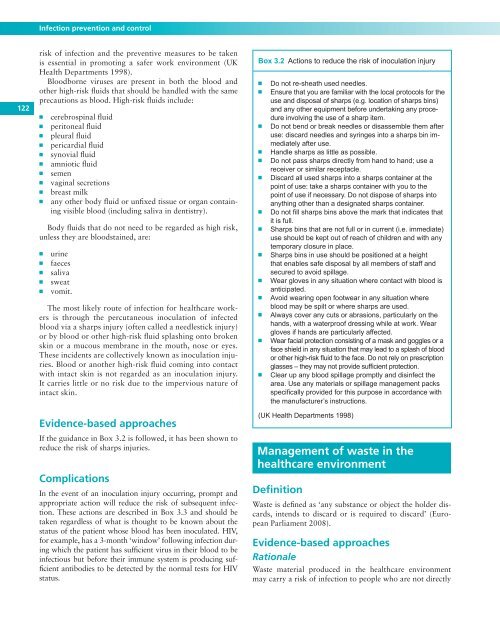Infection prevention and control - Royal Marsden Manual of Clinical ...
Infection prevention and control - Royal Marsden Manual of Clinical ...
Infection prevention and control - Royal Marsden Manual of Clinical ...
Create successful ePaper yourself
Turn your PDF publications into a flip-book with our unique Google optimized e-Paper software.
122<br />
<strong>Infection</strong> <strong>prevention</strong> <strong>and</strong> <strong>control</strong><br />
risk <strong>of</strong> infection <strong>and</strong> the preventive measures to be taken<br />
is essential in promoting a safer work environment ( UK<br />
Health Departments 1998 ).<br />
Bloodborne viruses are present in both the blood <strong>and</strong><br />
other high-risk fl uids that should be h<strong>and</strong>led with the same<br />
precautions as blood. High-risk fl uids include:<br />
■ cerebrospinal fl uid<br />
■ peritoneal fl uid<br />
■ pleural fl uid<br />
■ pericardial fl uid<br />
■ synovial fl uid<br />
■ amniotic fl uid<br />
■ semen<br />
■ vaginal secretions<br />
■ breast milk<br />
■ any other body fl uid or unfi xed tissue or organ containing<br />
visible blood (including saliva in dentistry).<br />
Body fl uids that do not need to be regarded as high risk,<br />
unless they are bloodstained, are:<br />
■ urine<br />
■ faeces<br />
■ saliva<br />
■ sweat<br />
■ vomit.<br />
The most likely route <strong>of</strong> infection for healthcare workers<br />
is through the percutaneous inoculation <strong>of</strong> infected<br />
blood via a sharps injury (<strong>of</strong>ten called a needlestick injury)<br />
or by blood or other high-risk fl uid splashing onto broken<br />
skin or a mucous membrane in the mouth, nose or eyes.<br />
These incidents are collectively known as inoculation injuries.<br />
Blood or another high-risk fl uid coming into contact<br />
with intact skin is not regarded as an inoculation injury.<br />
It carries little or no risk due to the impervious nature <strong>of</strong><br />
intact skin.<br />
Evidence-based approaches<br />
If the guidance in Box 3.2 is followed, it has been shown to<br />
reduce the risk <strong>of</strong> sharps injuries.<br />
Complications<br />
In the event <strong>of</strong> an inoculation injury occurring, prompt <strong>and</strong><br />
appropriate action will reduce the risk <strong>of</strong> subsequent infection.<br />
These actions are described in Box 3.3 <strong>and</strong> should be<br />
taken regardless <strong>of</strong> what is thought to be known about the<br />
status <strong>of</strong> the patient whose blood has been inoculated. HIV,<br />
for example, has a 3-month ‘window’ following infection during<br />
which the patient has suffi cient virus in their blood to be<br />
infectious but before their immune system is producing suffi<br />
cient antibodies to be detected by the normal tests for HIV<br />
status.<br />
Box 3.2 Actions to reduce the risk <strong>of</strong> inoculation injury<br />
■ Do not re-sheath used needles.<br />
■ Ensure that you are familiar with the local protocols for the<br />
use <strong>and</strong> disposal <strong>of</strong> sharps (e.g. location <strong>of</strong> sharps bins)<br />
<strong>and</strong> any other equipment before undertaking any procedure<br />
involving the use <strong>of</strong> a sharp item.<br />
■ Do not bend or break needles or disassemble them after<br />
use: discard needles <strong>and</strong> syringes into a sharps bin immediately<br />
after use.<br />
■ H<strong>and</strong>le sharps as little as possible.<br />
■ Do not pass sharps directly from h<strong>and</strong> to h<strong>and</strong>; use a<br />
receiver or similar receptacle.<br />
■ Discard all used sharps into a sharps container at the<br />
point <strong>of</strong> use: take a sharps container with you to the<br />
point <strong>of</strong> use if necessary. Do not dispose <strong>of</strong> sharps into<br />
anything other than a designated sharps container.<br />
■ Do not fi ll sharps bins above the mark that indicates that<br />
it is full.<br />
■ Sharps bins that are not full or in current (i.e. immediate)<br />
use should be kept out <strong>of</strong> reach <strong>of</strong> children <strong>and</strong> with any<br />
temporary closure in place.<br />
■ Sharps bins in use should be positioned at a height<br />
that enables safe disposal by all members <strong>of</strong> staff <strong>and</strong><br />
secured to avoid spillage.<br />
■ Wear gloves in any situation where contact with blood is<br />
anticipated.<br />
■ Avoid wearing open footwear in any situation where<br />
blood may be spilt or where sharps are used.<br />
■ Always cover any cuts or abrasions, particularly on the<br />
h<strong>and</strong>s, with a waterpro<strong>of</strong> dressing while at work. Wear<br />
gloves if h<strong>and</strong>s are particularly affected.<br />
■ Wear facial protection consisting <strong>of</strong> a mask <strong>and</strong> goggles or a<br />
face shield in any situation that may lead to a splash <strong>of</strong> blood<br />
or other high-risk fl uid to the face. Do not rely on prescription<br />
glasses – they may not provide suffi cient protection.<br />
■ Clear up any blood spillage promptly <strong>and</strong> disinfect the<br />
area. Use any materials or spillage management packs<br />
specifi cally provided for this purpose in accordance with<br />
the manufacturer’s instructions.<br />
( UK Health Departments 1998 )<br />
Management <strong>of</strong> waste in the<br />
healthcare environment<br />
Defi nition<br />
Waste is defi ned as ‘any substance or object the holder discards,<br />
intends to discard or is required to discard’ ( European<br />
Parliament 2008 ).<br />
Evidence-based approaches<br />
Rationale<br />
Waste material produced in the healthcare environment<br />
may carry a risk <strong>of</strong> infection to people who are not directly


